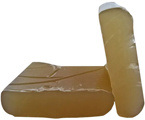 |
|
 |
|

Adhering materials are called adhesives, glues, gums, pastes, cements, mucilage, epoxies, caulks and sealants.
The type of raw materials used for adhesives can be sourced from plants, animals, or are synthetic such as cyanoacrylates (superglue), acrylic, polyurethane, amine, epoxy and silicone. They can be organic or chemical-based compounds that originate from hides (animal), rubber (plant) or petroleum (mineral).
Adhesives are usually categorised according to the type of substance and method utilised for joining. The basic criterion is whether the substance adequately reacts with the two materials or pieces and the weld hardens significantly increasing its strength and durability.
Drying adhesives are typically a mixture of polymer ingredients dissolved in a solvent, e.g. white/craft glue and rubber cement. PVA (Poly-Vinyl Acetate) is a 'synthetic' resin white glue of mineral origin, e.g. glue stick in solid form used for sticking some papers and fabrics.
Marine glue used by masons to caulk or seal seams for waterproofing consists of tar or pitch (from charcoal) and is not actually glue.
Natural or bio-adhesives are those made from inorganic mineral sources or biological sources such as vegetable matter (maize/cornflour paste, agar/marine plants, algin/seaweed), starch/dextrin, gum Arabic of plant origin (acacia or gum tree), natural resins, rubber based adhesives, animal blood, skins/hides, bones, horns & hooves (albumin, gelatine/hide glue, even fish glue and isinglass), casein (non-veg or lacto-veg) mixed with lime (water-proof glue), or even a homemade flour-cum-water paste. Zinc sulphate is added as a preservative to extend the keeping quality of animal derived glue.
Glue is in fact inferior gelatine (no difference chemically) and is sourced and processed exactly in the same manner as gelatine. Rejected hides and skins, hide trimmings such as marks, snouts, ears, shanks, skin of slunk/unborn animals, tendons, sinews, horn pith, casings and loose connective tissues are used to produce both glue and gelatine. Glue being low-grade is comparatively dark in colour to gelatine, and has inedible uses such as adhesive in plywood, furniture, sand paper and gummed tape. Animal glue is used – although not always – by carpenters (wood glue and varnish), weavers (sizing for textiles), cobblers (joining soles, uppers, etc of footwear), luthiers (for joining parts of musical string instruments) and plumbers (water-resistant animal glue which is further processed or obtained from mussels and some other water creatures).
Most manufacturers prefer animal derived glue called vajjram or saras, over polymer because it is stronger and the cardboard on which it is applied does not warp. It is obtained in slabs (looks like hard dark cooking chocolate) and is cheap. The slabs are immersed in hot water to melt and the resultant liquid or hot glue is used. It is particularly used for book binding as in ledgers, and for sealing cartons of packaged food articles and boxes.
That’s not all one needs to remember in order to avoid animal derived glue… following a ban on the use of plastic straws, paper straws are increasingly being used, but few people are aware that they are made by rolling three layers of bleached waste paper and dipping in glue. Those who use them for having beverages are indirectly consuming non-veg substances. |
| Page last updated on 07/02/22 |
|
|
 |
|
 |
|
|